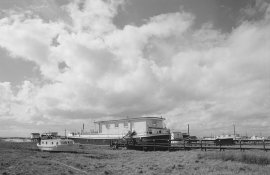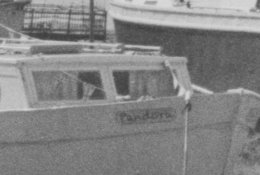Alan Johnson
Subscriber
- Joined
- Nov 16, 2004
- Messages
- 3,270
https://www.photrio.com/forum/threads/catechol-and-hydroquinone-stain.128555/
My previous experiment, posts 19 and 24, produced faint tanning with HQ at pH 10.Here I used Glycol-Metaborate to produce a 1-shot developer, diluted 1:50. The same 2008 Tri-X film was used.
MGQ
Monopropylene Glycol.............................65ml
Ascorbic acid............................................5g
Hydroquinone............................. .............10g
Phenidone.................................. ............0.4g
Sodium Metaborate Tetrahydrate..... ......40g (3 different tested , note below)
Monopropylene Glycol to make...............100ml
Dissolve each completely in order given ~190F (Hazardous). pH 1:50 ~9.7
Sodium Metaborate tested was 10g, 20g and 40g per 100ml giving 1:50 working solutions (pH paper)~ pH 8.3, 9.0, 9.7.
Staining was noted only at pH 9.7, and prints from pH 9.7 solution appeared slightly sharper than those from pH 9.0.
pH 9.7 negatives bleached and fixed showed a very faint relief image (tanning) as per previous experiment post 24.
The slight sharpness increase at pH 9.7 may be due to faint tanning or a natural effect of pH with Acutance developer.
Development time was around 15min 20C.
MGQ is not a tanning developer in the same league as Pyrocat or 510 Pyro.
My previous experiment, posts 19 and 24, produced faint tanning with HQ at pH 10.Here I used Glycol-Metaborate to produce a 1-shot developer, diluted 1:50. The same 2008 Tri-X film was used.
MGQ
Monopropylene Glycol.............................65ml
Ascorbic acid............................................5g
Hydroquinone............................. .............10g
Phenidone.................................. ............0.4g
Sodium Metaborate Tetrahydrate..... ......40g (3 different tested , note below)
Monopropylene Glycol to make...............100ml
Dissolve each completely in order given ~190F (Hazardous). pH 1:50 ~9.7
Sodium Metaborate tested was 10g, 20g and 40g per 100ml giving 1:50 working solutions (pH paper)~ pH 8.3, 9.0, 9.7.
Staining was noted only at pH 9.7, and prints from pH 9.7 solution appeared slightly sharper than those from pH 9.0.
pH 9.7 negatives bleached and fixed showed a very faint relief image (tanning) as per previous experiment post 24.
The slight sharpness increase at pH 9.7 may be due to faint tanning or a natural effect of pH with Acutance developer.
Development time was around 15min 20C.
MGQ is not a tanning developer in the same league as Pyrocat or 510 Pyro.













